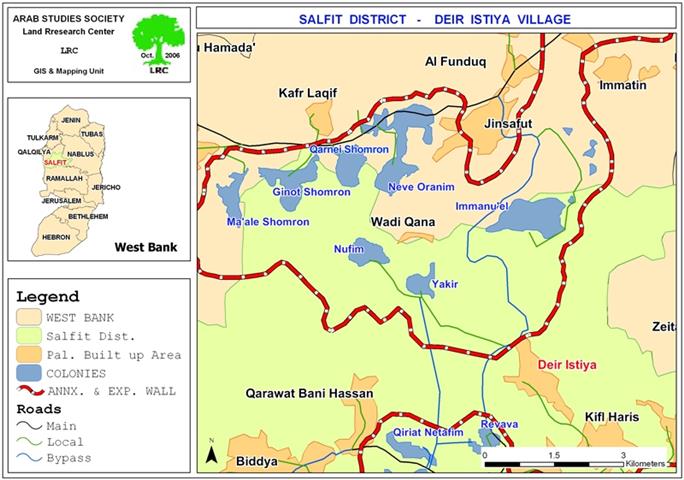On May 18, 2009, the regional council for Israeli colonies in the Jordan Valley announced a tender to built infrastructure for a new quarter in Maskiyyot colony. Commenting on this development, the head of the council, David Elihani, said that the settlements and settlers in Jordan valley are of national benefit for Israel and they constitute the eastern security built for the state. According to the Israeli Peace Now movement the announcement of the tender synchronized with the Israeli prime minister's Benjamine Netanyaho's visit to the USA in a clear sign that his government is determined to go ahead with the settlement in the occupied territories.
( photo 1: Location of Maskiyyot colony)
30 Jewish families to be moved to Maskiyyot
The colony of Maskiyyot started as a military base in 1979 because of it's strategic location overlooking the Jordanian territories. In 1987 the Israeli army withdrew and base was changed into an agricultural colony whose total population reached 507 in the year 2000 and whose surface land area was 512 dunum (Source: Foundation for Middle East Peace) with a lot of incentives offered to settlers by successive Israeli governments. But, after the start of the second Palestinian Infitfada (uprising) on 28 of September, 2000, it was totally emptied of it's population. It remained empty until the Israeli unilateral withdrawal from Gaza Strip in August, 2005, when a group of settlers' families chose to be re-allocated in Maskiyyot colony. Following this move the Israeli ministry of interior considered the colony as permanent and allocated budgets for further construction and development. The latest tender's announcement came as part of this policy and 30 Jewish families are expected to be re-settled there once the project is done. An additional 20 housing units are going to be constructed inside the colony to serve this goal at the expense of the land owned by Palestinians from Tubas governorate. Agricultural farms and facilities are planned to be built as part of this scheme to serve the Israeli settlers.
( Photo 2: on the right is the edge of Maskiyyot colony)
All these measures are being taken at the time the current Israeli prime minister claims to have eased restrictions and introduced improvements on the life of Palestinians in the West Bank service of the peace process.
Maskiyyot: a source of continued provocation
Ever since it's appearance in 1979 Palestinian farmers, land owners and Bedouin communities who live in Khirbet Humsa and Wadi Al Maleh have been suffering from daily attacks and provocations against their very existence. These attacks include confiscation of land, seizure of water resources, dismissal of shepherds and cattle from grazing zones, deprivation from using agricultural land, destruction of crops and intermittent military closures. All the land around the colony was announced as closed military zones in accessible to Palestinians, although most of it is privately owned and should be given back to it's legitimate owner's once the army control is over, but, instead, it was handed over to Israeli settlers in violations of the existing Israeli law.
Israeli colonies in the northern Ghor region
The northern Ghor region constitutes about 30% of the total area of West Bank. After the occupation of 1967 it was announced as a closed military area limited to Israel's army use, however, 21 colonies in which 2500 settlers live were established. What is going on in the Ghor region at the current time is, in fact, a mere implementation of the second stage of the Israeli plan to control more than 60% of the total area of the West Bank. The first stage was represented in the construction of the western Wall zone, and the second stage in the eastern Wall zone, the purpose of which, among other things, is the following:
1. Build a front line barrier of colonies and military installations in the face of the so-called eastern threat;
2. Control the eastern water aquifer of the West Bank;
3. Building more agricultural and industrial zones in the area;
4. Creating a geographical barrier between the future Palestinian state and Jordan.
5. Creating more realities on the ground to consolidate the Israeli claim that the Ghor area is not part of any future negotiations between the Palestinian and Israelis.
Photo 3: The Jordanian territories facing Maskiyyot colony
To achieve these goals the Israeli occupation authorities in 2005 issued a decision giving the Ghor region the status of top priority as regards budget allocation and development projects. Immediately after that decision, 85 Million Shekels were allocated as an emergency budgets for the years between 2006 and 2008 with the primary goals of improving the agricultural sector and expanding the young couples to settle there.
Prepared by:
The Land Research Center
LRC
















